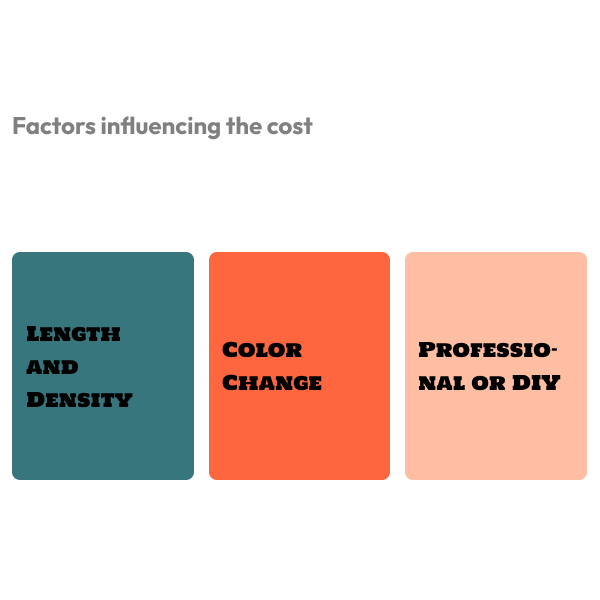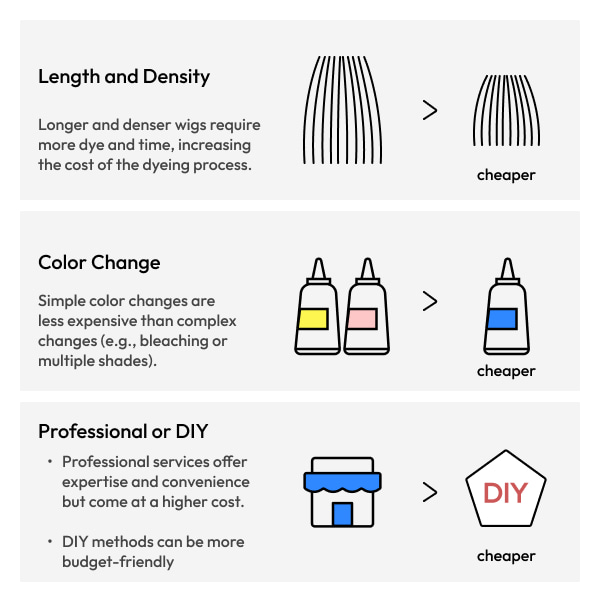


How much does it cost to dye a wig?
Introduction
Dyeing a wig can be an effective way to change your look without purchasing a new wig. Whether you opt for professional services or choose to dye the wig yourself, understanding the costs involved can help you budget effectively. This article explores the factors that influence the cost of dyeing a wig and provides an overview of both professional and DIY options.
Factors Influencing the Cost
Type of Wig
- Human Hair Wigs: Generally more expensive to dye due to the quality of the hair and the products needed.
- Synthetic Wigs: Typically cheaper to dye, but require specific dyes and techniques that might affect the overall cost.
Length and Density
- Longer and denser wigs require more dye and time, increasing the cost of the dyeing process.
Color Change Complexity
- Simple color changes (e.g., darkening the hair) are usually less expensive than complex changes (e.g., bleaching or multiple shades).
Professional vs. DIY
- Professional services offer expertise and convenience but come at a higher cost.
- DIY methods can be more budget-friendly but require time, effort, and the purchase of specific materials.
Professional Dyeing Services
Cost Range
- Basic Dye Job: $50 to $100 for simple color changes on short to medium-length wigs.
- Complex Dye Job: $100 to $300+ for intricate color changes, bleaching, and longer wigs.
What’s Included
- Consultation: A professional will assess your wig and discuss your desired color.
- Dye Application: The professional will apply the dye evenly and precisely.
- Treatment and Care: Post-dyeing treatments to maintain the wig’s quality and color longevity.
Advantages
- Expertise: Professionals have experience in dyeing wigs, ensuring even color and minimal damage.
- Convenience: Saves you time and effort compared to DIY methods.
- Quality Results: Professional dyeing often results in a more natural and longer-lasting color.
DIY Dyeing Methods
Cost Range
- Human Hair Wigs: $20 to $60 for materials, including hair dye, developer, and other supplies.
- Synthetic Wigs: $10 to $30 for materials, including fabric dye or specific synthetic hair dyes.
Materials Needed
For Human Hair Wigs
- Hair dye (semi-permanent or permanent)
- Developer (if using permanent dye)
- Mixing bowl and brush
- Gloves
- Plastic wrap or aluminum foil
- Shampoo and conditioner
- Towels
- Wide-tooth comb
For Synthetic Wigs
- Fabric dye (e.g., Rit DyeMore for synthetic fibers)
- Large pot (for boiling water method)
- Gloves
- Towels
- Wide-tooth comb
Steps for DIY Dyeing
1. Prepare the Wig
- Clean the Wig: Wash the wig to remove any product buildup.
- Secure the Wig: Place the wig on a stand to keep it steady.
2. Mix and Apply Dye
- Mix the Dye: Follow the instructions on the dye package.
- Apply the Dye: Section the hair and apply the dye evenly.
3. Process the Dye
- Let the Dye Set: Allow the dye to set for the recommended time.
- Rinse and Condition: Rinse the wig until the water runs clear and apply conditioner.
4. Dry and Style
- Dry the Wig: Gently squeeze out excess water and let the wig air dry.
- Style as Desired: Once dry, style the wig as needed.
Tips for Budgeting
- Compare Prices: Get quotes from different professionals to find the best price for your budget.
- DIY Considerations: Factor in the cost of materials and the value of your time when considering DIY methods.
- Sales and Discounts: Look for sales on dyeing products or discounts from professional services.
- Quality Over Cost: Sometimes paying a bit more for quality results is worth the investment.
Your questions answered
FAQs
Is it cheaper to dye a wig yourself?
Yes, DIY methods are generally cheaper, but they require time, effort, and some skill to achieve good results.
Can I use regular hair dye on a synthetic wig?
No, regular hair dye does not work on synthetic wigs. Use fabric dye or dyes specifically designed for synthetic fibers.
How often can I dye my wig?
Dyeing too frequently can damage the wig. It’s best to wait several months between dye jobs and to follow care instructions to maintain the wig’s health.
What if I don’t like the color after dyeing?
For human hair wigs, you can redye or correct the color. For synthetic wigs, it’s more challenging to correct mistakes, so it’s important to test a small section first.
How can I extend the life of my dyed wig?
Use sulfate-free shampoos and conditioners, avoid excessive washing, and protect the wig from sun exposure to maintain the color.
Can professional dyeing damage my wig?
Professionals use techniques and products designed to minimize damage, but any chemical process carries some risk. Ensure you choose a reputable professional to reduce this risk.